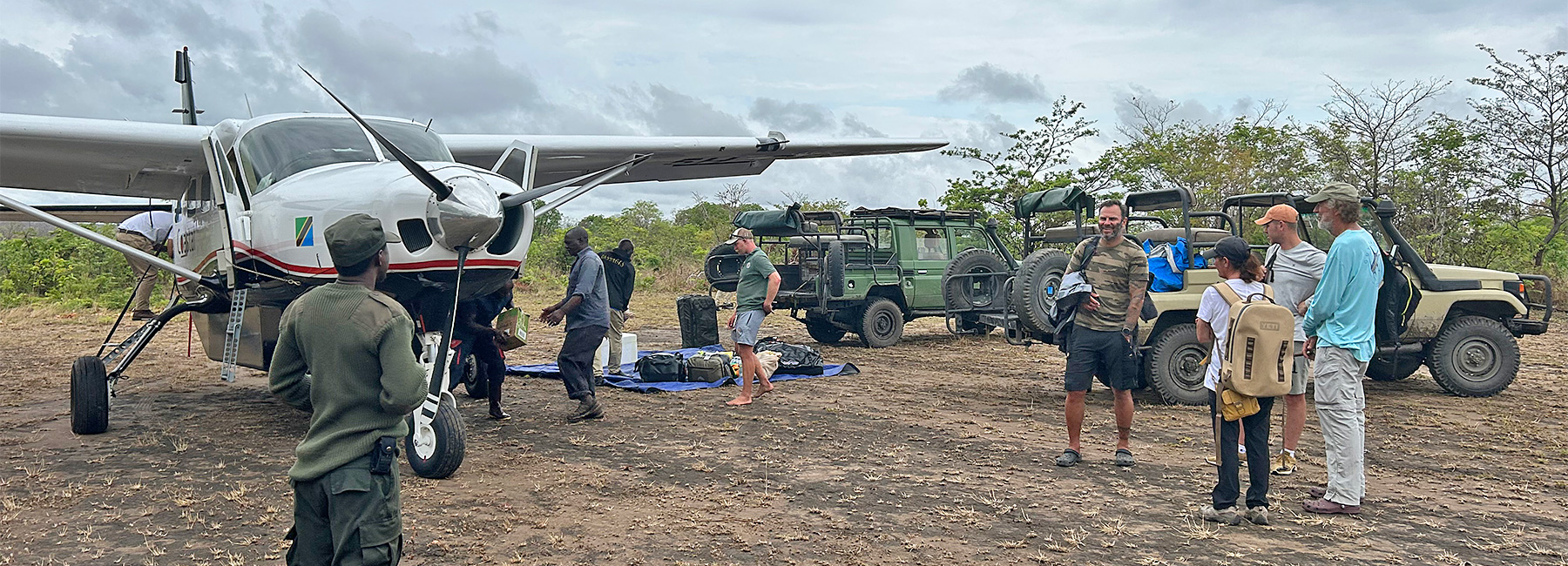2023 Tanzania Trip Report – November 1 – 13, 2023
by Erik Argotti
November 1:
I arrived at the Redding airport around 5 am for a 6 am flight to SFO. Took off on time and arrived in SFO around 7. Smooth and easy. According to the board, the Turkish Air counter was supposed to open at 10 am.They were having some internal system shut down so counters didn’t open until noon. My flight to Istanbul was supposed to depart at 1:50 pm, but because of the delay in getting the system up and running the flight was delayed until 3:50. Once it opened people were swarming and the line was long and it was slow getting checked in. I was in the middle and got through after 1 pm. Security wasn’t terribly bad, maybe half an hour to get through. Once through security, I got a bite to eat and the flight got pushed out to 4:30 then 5. We started boarding around 4:45 and finally took off just before 6. At that point it didn’t matter, my flight from Istanbul to Dar es Salaam was at 2:30 pm on November 2 which was only a 1 hour 30 minute layover, so I wasn’t going to make that flight. The next flight wasn’t until 7:30 pm on November 3, which would put me in Dar es Salaam around 3:30 in the morning on the 4th, which would give me a few hours to meet the charter into the rivers. Perfect example of why it is a good idea to give yourself time for these big trips.
November 2:
I landed in Istanbul around 5:15 pm on the 2nd.
The whole Turkish Airline system shut down, so all flights were delayed from the 1st. Everyone was getting rescheduled. I’ve never waited in so many lines. Nobody knew what was going on and I think most people missed their connections on my flight. We all went to the first desk and I waited half an hour for a guy to tell me they already switched my flights to the next day at 7:25 pm and I had to get in another longer line to get my boarding pass. I figured I’d have time the following day. He told me vague directions to a free hotel desk. I asked a few different people on the way and nobody knew. It seemed like you had to wait in line for someone to tell you to go somewhere else. I finally made it out of an exit and was told to go to passport control…passport control lines kept telling everyone to go farther down until we were in a Connections line. I went back to a passport control line, waited for half an hour, and the guy sent me back in and said I needed a visa. I went back in another line and paid $30 for a visa, then back in the passport control line. There was a guy on the same flight as me that I kept running into as we roamed around, and he told me the “free” room was still $60 in taxes. I made it outside and talked to a guy at a hotel kiosk who said he could get me a hotel for $150 at the Grand Hamit, 20 minutes away (similar to what our travel agent Alicia told me, without transfers). I told him I would check out the “free” hotel area. I walked down and the line was looooong… I was guessing a few hours of waiting. I walked back to the kiosk guy and told him, “Let’s do it”. Once I agreed and he wrote it up and ran my card, I looked at the receipt and converted it to dollars and saw that he had charged me $280! I said absolutely not, and he said he would give me cash back. We settled on $200 with transfers and breakfast and a late check out. Probably a little high, but I just wanted somewhere to sleep. After a couple taxi rides on the way back, I realized these Turks are master swindlers. Saying one thing and doing another. Always trying to get more money. I made it to the hotel by 8:30 pm., showered and passed out. I found out later it was a 4-hour wait to get through the “free” hotel line.
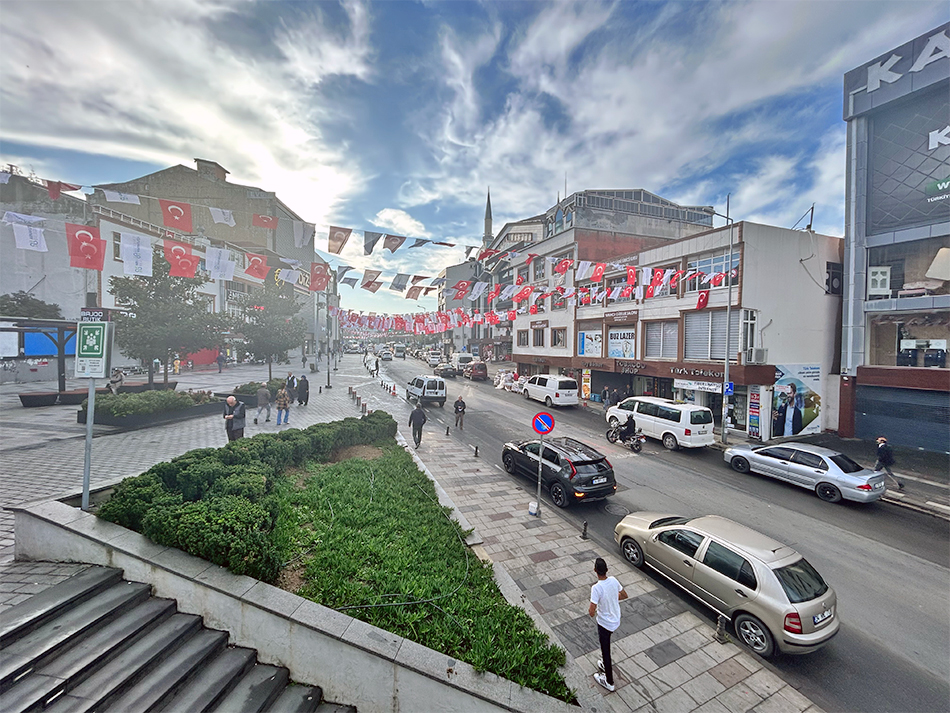
November 3:
I got up early, around 4:00 am, so I checked some emails and looked online for places to check out close to me. Breakfast was at 7:00 am and I was scheduled to be picked up at 1 pm to go back to the airport. Breakfast was really good. Lots to choose from – fruit, cheeses, olives, breads and pastries. I took a walk up and down the street to have a look around. It was busy. I tried not to get hit by a car. There were lots of dogs in the streets who clearly knew the rules better than me. Back at the hotel, I packed up at 1:15 pm and was back to the airport a little after 1:30 pm. I got my bags run through the initial checkpoint, then onto a long, slow recheck-in line. I got through, and they gave me my new boarding pass. My bag was already checked from SFO to Dar so I moved through passport control, then a second security line to get to the gates. Busy lines for both but not terribly long. Once in security, they had my bag apart, and one reel and my two spare lines came out. The Patagonia rod roll was not very popular. All four rods out of the case, as well as the rod socks. Mind you, I got these through San Francisco and asked the lady at the Turkish Airline counter if I could carry them on. She said no problem, and there weren’t any issues. If I wouldn’t have been delayed or hadn’t left the airport in Istanbul, I would have been fine. I had at least a dozen people look at the “illegal stuff”. There was lots of talking, lots of “no problems”, and minimal English. Those Turks are not really good at telling you what you can do, but the best at telling you what you can’t do. The final pronouncement after about a 1-hour dissection of my gear was a “no go”. I told them there was no way I was going to leave them, so I needed to re-check them. Lots more talking and meeting with more people. But in the end, I had to do what I did the night before. Exit – which was way on the other side of the airport – through passport control, which created its own problems as I was boarding in a few hours, so people were confused as I went through 2 checkpoints. I made it out and back over to international departures and after getting shuffled around a couple of times and waiting in lines, I finally found the rods and had to go do it all over again. I bought a cheap duffel at a little shop and stuffed all the “contraband” in it. Back to the Turkish Airlines “check in” line and it was even longer than the first time. I got the bag checked and the lady tried to charge me for oversized luggage because they were fishing rods. I said, “I’ll measure it to anyone’s bag in line.” She let it go.
Back through passport control then security… ahh. Made it back through right around 5:00 pm. Plenty of time, but only because I got there at 1:30 pm for a 7:25 pm flight. Not really by choice, but I’m glad that’s what I did. I went right to the bar for a beer. I don’t get stressed very often, but that one got me a little, considering how things seem to go at this airport. I got a bite to eat, loaded onto the plane and we took off at 7:45 pm. 20 minutes late. I’ll take it.
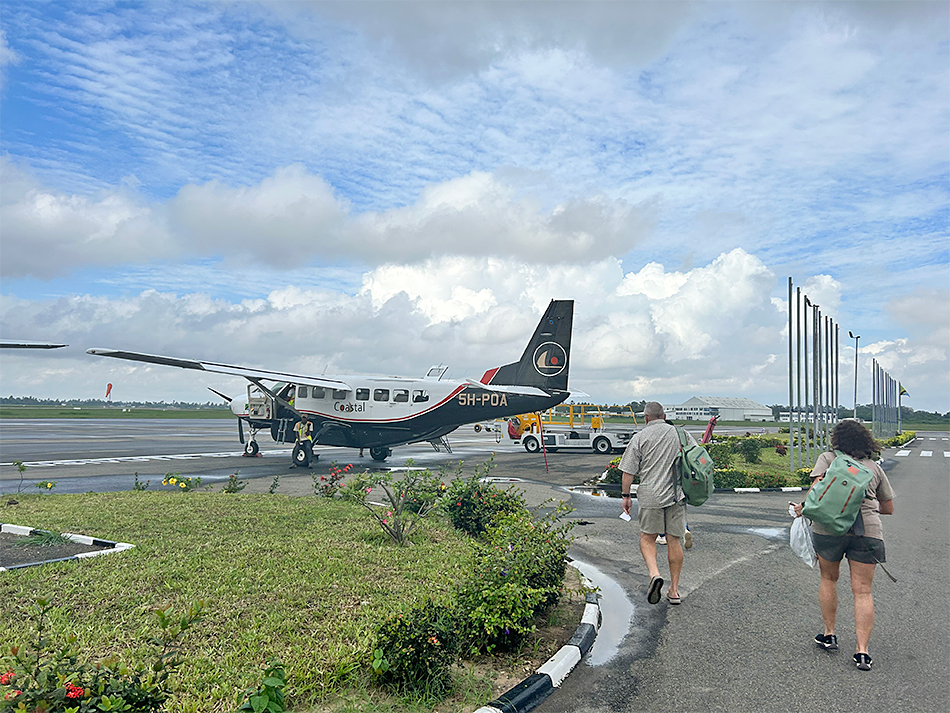
November 4:
We landed in Dar es Salaam at 2:40 am. I paid $100 for a Tanzania Visa, made it through customs, and an hour later showed up to find my Patagonia Black Hole duffel on the carousel, but not the rod bag that I checked late. There were at least 30-40 people without bags. There was a long line of people waiting to fill out a lost luggage form and everyone was pushing forward to get the help of two people behind the desk, who were very patient. Passengers, on the other hand, were getting restless and irritated. I got my paper filled out and turned in and told them to send my stuff to the Sea Cliff once they got it. I accepted I would be without rods, one reel, extra lines, and my rain jacket. Took a short taxi ride to domestic Terminal 1, had some breakfast and waited for the group. I met Sam and Linda as well as Greg, who I would be spending the week with. I also met Malta from Germany and Micha from Sweden. These two guys do a lot of traveling and have been to both Gabon and Cameroon with African Waters. They talked very highly of both locations. We all hung out, chatted, and got acquainted while we waited for the Colonial Air charter flight. Sam and Linda had arrived on the 3rd, without their bags. No clothes or rods, so they raided the gift shop at the Sea Cliff for some extra tourist shirts and shorts. This was a crew of seasoned travelers so no complaints. They have traveled all over and were prepared to make the best of it. We took off in the charter around 9:00 am and landed at 10:40 am on the dirt airstrip. Kyle (guide) and the drivers were there to meet us. The last group had great fishing except the last 2 days when it started raining. One of the guys got a 23-pound fish! We hopped into the safari-style vehicles and made it to the Dhala Camp (Mnyera River) around 11:30 am. On the drive to the camp we saw a bunch of elephants – so cool! I was in full tourist mode, as it was all new to me. We arrived at camp to a singing welcome by the local staff and met the rest of the guides, Greg (head guide), Blade and Oliver. We received the briefing by Blade on what to expect for the week and got settled into our tents. We were staying at the Mnyera so we could be there when/if the bags showed up because the hunting camp had a plane coming in the following day. The two Euros were heading to Samaki Camp (Ruhudji River). We all had lunch together, and they took off around 2:30 pm for the drive to the Ruhudji. The guides got us all rigged up and ready to fish the following day. They have 4 Echo rods to use at the lodge. Sam, Linda and I all had reels to put on the rods so they took 3 rods and I took one. I lent them wire, leader material, and a bunch of flies. The camp has plenty of gear for sale if you forget or lose anything. Lines, leaders, wire, and flies. We hung out for a little and then Greg and Kyle took us out in the evening to a spot to glass some animals and birds. They also brought the necessary components to make some gin and tonics, a nice touch. They set up chairs and we saw lots of Puku-antelope, warthogs, elephants and tons of birds including a fish eagle. We made the drive back in the dark and had dinner around 8:30 pm. Good way to start the trip.
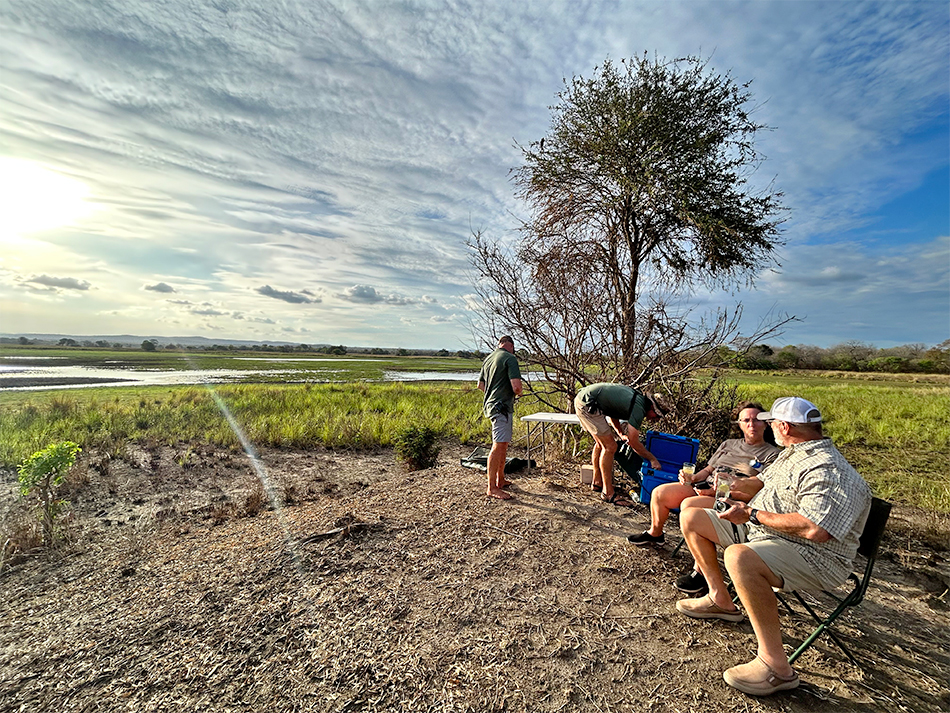
They are really loose on the schedule, but below is a general time table of what to expect:
- Wake up call at 6:00
- Breakfast at 6:30
- Out by 7:30
- Lunch around 12:30
- Back out fishing at 3:30
- Back to camp 5:30-6:00
- Dinner around 8:30
November 5:
I got a wake-up call at 6:00 am and headed over for breakfast. Made-to-order eggs with bacon and toast. There was also a tray of fresh fruit with yogurt. Very nice outside dining for dinner and breakfast, right by the river. We were fishing with Greg just below camp, with plans to meet back at camp for lunch. There were heavy rains on Wednesday and Thursday that had brought the river up probably 18”-plus. It was still rising, with very low visibility (probably 4-6”), and the water temperature had also dropped according to the guides. You could tell they weren’t expecting much. The river was high and muddy.
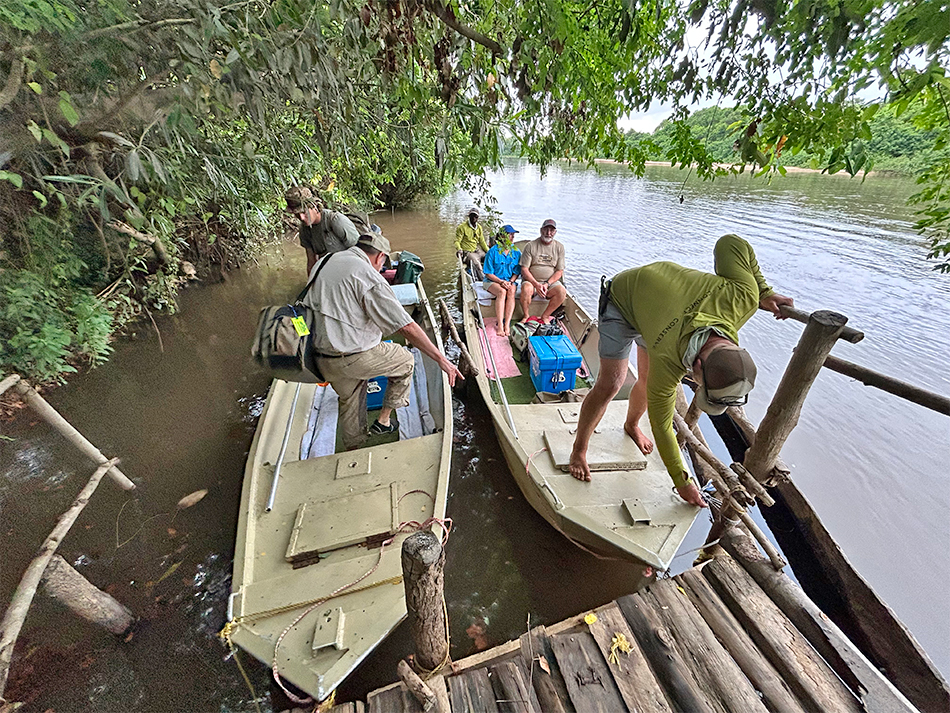
You have an English-speaking African guide as well as a local boat driver. They pole you down the river as well as anchoring up in some fishy spots. I was surprised at the different styles of fishing. Some sections involved poling down banks casting at structure. We also fished mid-river on some clay flats, as well as anchoring up on runs and some drop-offs at the heads of pools, and into the pool itself. Greg liked the deeper runs. I am guessing that is where he had been catching fish. We had our first run-in with a hippo. The boat driver and guides do not like the hippos – you can tell everyone gets on edge around them. They are aggressive and very territorial of their spot on the river. You can hear the hippos honking and letting you know they don’t like you close to their hole. The driver gets the boat on step, the hippo dives under, and you wait to see if he pops up as you go by. This time he did, 20 feet from the boat and coming towards us. For their size they are fast movers, both in the water and on land. Once we got past the hole, he honked and blew water, and strutted, no doubt in hippo-ese saying, “That’s right, get out and stay out!” There are plenty on the river and the guides mostly know what holes they are in. If you are in the hole and not on step, the hippos will bump the boats. Both boat drivers and guides have been knocked in the water during past encounters. If you are in the water with a hippo, it typically doesn’t end well. In Africa, hippos kill 500 people per year, compared to only 22 by lions.
 It was tough fishing. I hooked one small tigerfish that shot up the river, jumped and got off pretty quickly. It was little but a good introduction to how ferocious this species hits, then runs. It hit like a little GT, explosive and angry. A little later I had another grab, but never stuck it. About an hour later I had one more take and stuck him and it seemed like a better fish, but it got off after a couple of seconds as it rocketed up river. Sam was the only other person who had a hit that day. The water came up during the morning, peaked around lunch and started dropping in the afternoon. When we returned to the camp, we saw that Linda and Sam’s bags showed up. Mine didn’t make it. I think they were going to show up on this day, but there were no more planes coming in. Drinks by the fire followed by a good dinner. Everyone was in relatively good spirits considering the conditions and the day.
It was tough fishing. I hooked one small tigerfish that shot up the river, jumped and got off pretty quickly. It was little but a good introduction to how ferocious this species hits, then runs. It hit like a little GT, explosive and angry. A little later I had another grab, but never stuck it. About an hour later I had one more take and stuck him and it seemed like a better fish, but it got off after a couple of seconds as it rocketed up river. Sam was the only other person who had a hit that day. The water came up during the morning, peaked around lunch and started dropping in the afternoon. When we returned to the camp, we saw that Linda and Sam’s bags showed up. Mine didn’t make it. I think they were going to show up on this day, but there were no more planes coming in. Drinks by the fire followed by a good dinner. Everyone was in relatively good spirits considering the conditions and the day.
November 6:
The plan was to run up the river a ways and fish back down and have lunch on the river. Tough day. Same as the first day, we fished a mix of different spots, but the water was still really high and off-colored. I’m not sure if anyone had a grab all day. We had lunch in a nice little spot, put up hammocks and relaxed for a siesta. After lunch we headed out – it was hot and it felt like we were just going through the motions in the high water. We fished a half hour after lunch, then the sky to the east of us began to grow dark. It started getting really windy, with thunderstorms and lightning in the distance heading our way, so we tucked under a tree to wait it out. It started raining, then pouring and we were getting soaked, especially me without a rain jacket. After about 10 minutes Greg came cruising by and we decided to follow him and make a run for it in the rain. We made it back to camp and it was still coming down pretty heavy, so we got under the dining tent and figured we would have a couple beers. The rain didn’t let up, though, and the tent was catching lots of rain on the edges…the crew had to push it off so the eves didn’t collapse. It rained until close to dinner at 8:00 pm. Hard day. They said it is very uncommon to get rain during the season, it’s usually hot. The rainy season doesn’t usually start until early December. We had a nice dinner around 8:30 pm and then went to bed.
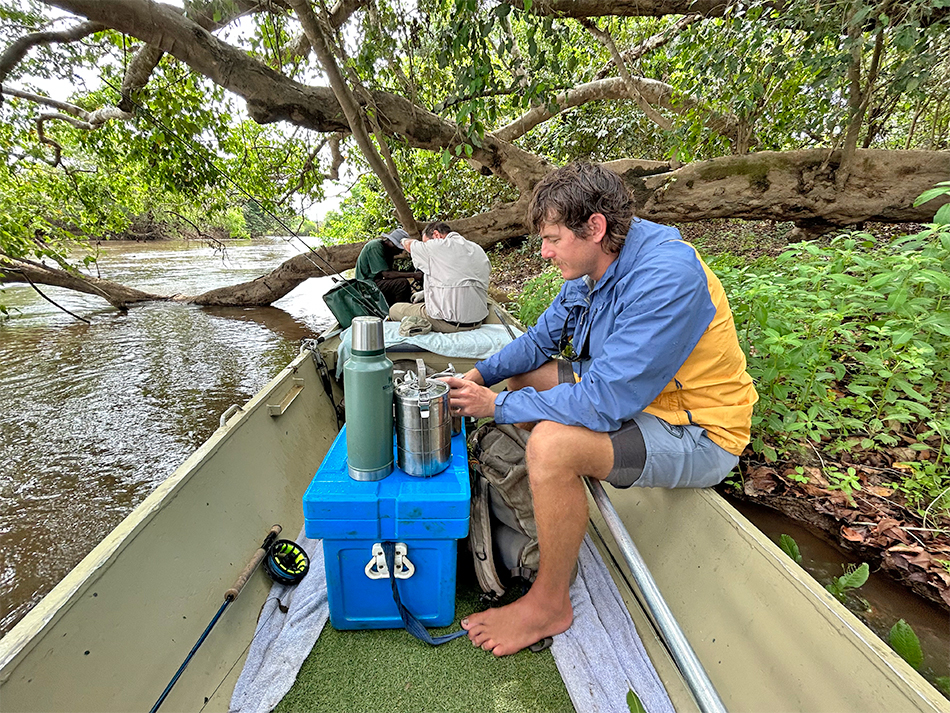
November 7:
We woke up to overcast skies, but no rain. We were all set to head up the river to the rapids section, hike up and fish off some of the rocks. The general feeling was positive, but I don’t think anybody was expecting much considering all the rain after the water was already high. This crew of guests has been around and traveled a lot, so they have seen the good and bad. This was definitely not good so far. We ran up 30-45 minutes and started fishing below the rapids. Clarity was still very minimal, maybe 6 inches. We wanted to believe it cleared up some, but I think it was wishful thinking. At the first spot we fished off some mid-river boulders a good ways below the rapids. Nothing. We fished another rock in the river at the next spot – not a bump. We jumped in the boat and anchored up behind a rock and I saw a fish move and break water and threw a sloppy cast to it and the fish whacked it. It felt more like it grabbed the back of the fly. I had another one grab my fly in the same spot a half dozen casts later, but I didn’t connect. We moved upriver to just below the lowest rapids and fished a long run, then a tailout before we headed to the next run. Nothing. We moved over, parked the boat and started hiking upriver to the upper rapid section. I think Greg said it was a 1.5 km hike. We saw two Pel’s fishing owls, a very rare sighting of a really cool bird. The bird was so big, it looked like a toddler in a tree. It’s a bird Kyle has been on the search for but has never actually seen, so Greg told us to rub it in when we saw him. Both those guys were really into the birds and knew so many species – usually when you pointed one out, they knew what it was. We cast to a couple of spots on the walk up, but it was tight and difficult to actually cover any water. We made it to the lunch spot and had lunch and a little break with Sam and Linda. The lunch was great again, then we rested in the hammocks for about an hour. After lunch Sam and Linda hiked straight back to the boats to fish the river below where we parked. We made our way back to the boats, stopping and casting in the few openings available, but with the high and dirty water we were limited. No fish, no hits. We made it back to the boat and had an hour to give it a go. Greg got a call on the radio that Linda had landed a 6 lb fish and lost a nicer one and had a couple of other grabs. It gave us a sliver of hope. Fishing some water that we’d hit earlier, Greg had a couple of short strikes but didn’t land anything. We made our way back to camp just before dark and met back up with Micha and Malta. They had a great last day on the Ruhudji. They said they must have gotten into 60 fish, meaning hits and hookups, but lost most, of course, as is the norm for tigerfish. Apparently they landed several this day but said their first two days were slower. Their biggest fish was 10 lb. The Ruhudji didn’t get as much rain and Blade said the river didn’t cool off as much as on the Mnyera. They also put out a bait rod at lunch and landed a huge 100+ lb Vandu (catfish) on their second day. Blade was pretty excited about it. It gave us hope. We all had a nice dinner together and off to bed.
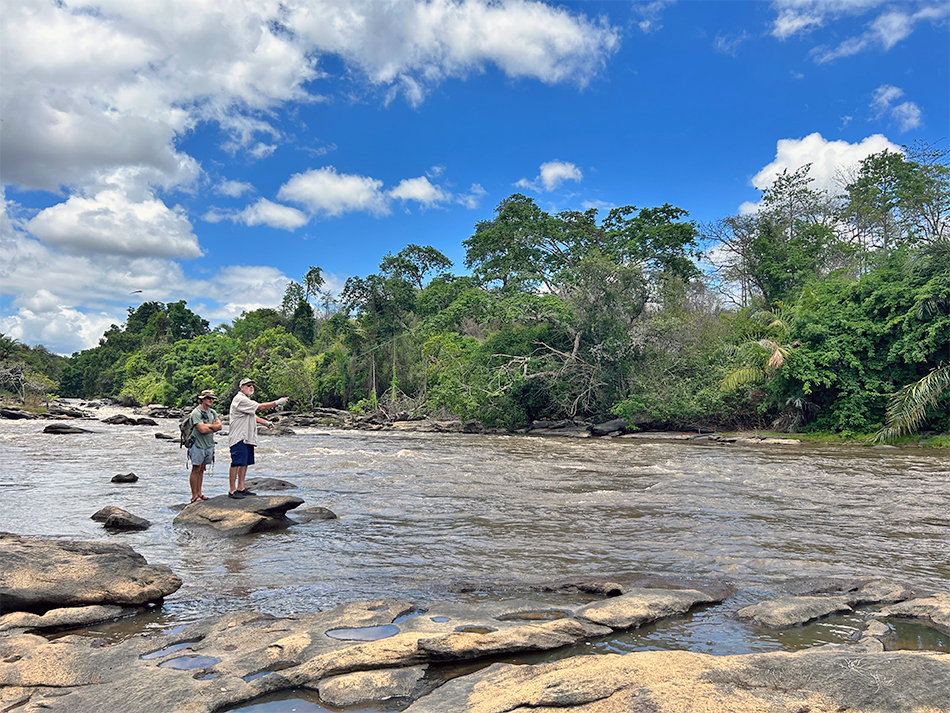
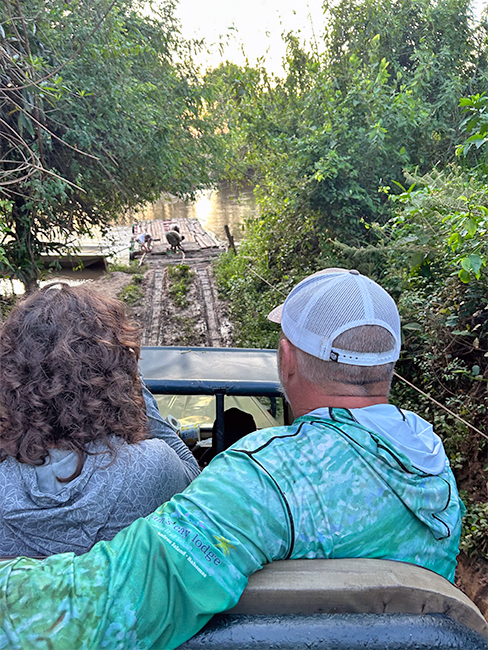 November 8:
November 8:
Up earlier than normal, 5:00 am, and it was still dark. We left at 5:45, crossed the ferry at the hunting camp for the 2-2.5 hour drive (depending on road conditions) to the Ruhudji. Kyle came with us and Olly was the other guide waiting over there. It was a beautiful drive/safari – we saw lots of game, including Puku, elephants, reed buck, hartebeests, a duiker, waterbucks, warthogs, vervet monkeys, baboons and lots of cool birds including guinea fowl, Francolins, Purple-crested Turaco, and Narina trogon. We arrived at camp at 8:20 am. – the driver made it in good time. We got settled in and were on the river and fishing by 9:30 am. The water was way down (normal) so you could see the channels, and visibility was probably close to a couple feet. It looked great. The Ruhudji is probably about 30% smaller than the Mnyera. I really liked this river, smaller and more intimate. We ate breakfast and headed out. The plan was for one boat to head up from camp and fish down and one boat to start fishing down, have lunch at camp, and then switch. Our boat ran up for 15 minutes or so. We fished floating lines mostly, but mixed in some sinking tips in the deeper holes. The first spot I had a grab on the third cast. Completely different day. We had lots of action with fish following, hits, fish on and lost. With the floating lines being just under the surface, many of the takes and follows were visual. I caught my first fish – 6 lbs – on a sinking tip and a black and orange Andino’s Deceiver. Not too long after that, I got an 8 lb fish on a black and purple redfish fly on a floating line – we put it on for the dumbbell eyes to get a little deeper. I lost a couple nice fish on jumps, then landed my best fish, a beautiful specimen of 10 pounds. Burnt my finger on the strike. It is hard to describe the way a tigerfish takes, especially the bigger fish. So fast and explosive. I’m not sure you really set the hook most of the time – you just hope to maintain some degree of control and not give them slack when they tear the line out of your hand. Greg had some hits and misses, but didn’t get any fish – we both had some more action and then headed back for lunch. Sam and Linda were excited about the action as well, and they had landed a couple of fish. We had a nice meal and a rest before we swapped locations after lunch. Greg and I both got one smaller fish after lunch, both around 5 lbs. Same as earlier, plenty of action to keep you in the game. Earlier in the week when I asked Greg (guide) what the hook-to-land ratio was, he said 10 to 1. Oliver said that was being very generous. After lunch Sam and Linda hooked and lost 3 big fish. Olly said they were the 3 biggest fish he has seen all season. Two 20+ pounds and another really close to that in one session, all lost. They were fishing the same water we had fished earlier that morning. One took Sam right to the backing and kept going before shaking loose. Linda hooked a big one that burned her hand, so she let go of the line, when she grabbed it the fish was still on and headed right for some logs – it found one, and was off. Olly was pretty heartbroken. Before dinner, Kyle made some casts on a sandbar right in front of camp and landed a yellowfish on a little nymph.
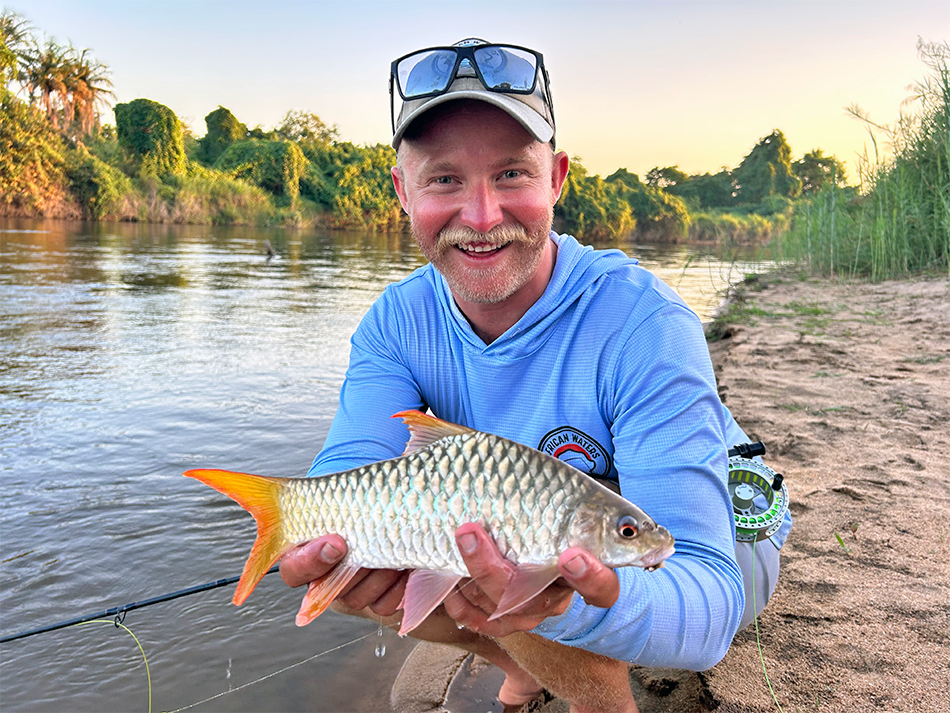
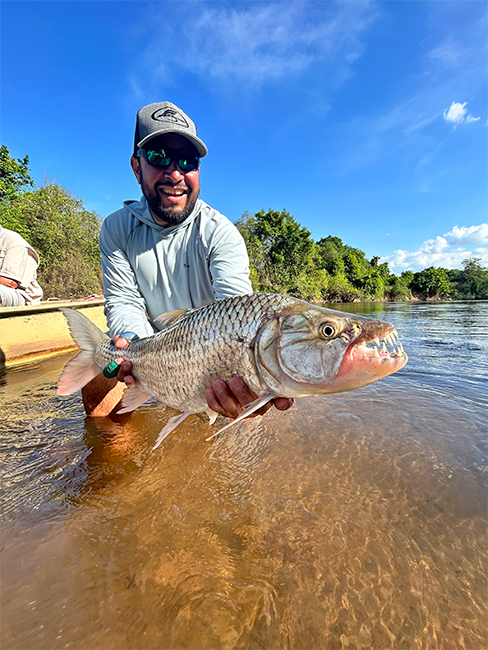 November 9:
November 9:
We were scheduled to head up the river and spend the day. It was a 2-hour boat ride. Sam, Linda and Kyle went up higher and we started below them. Same as the day before, plenty of action, definitely some more small fish in the mix swiping at the flies. We missed and lost our fair share of fish. It seems those smaller fish nip at the fly more, maybe trying to bite off the tail of (what they think is) the baitfish. The big fish don’t seem to do that as much – they take the fly with authority. Same routine, mostly floating lines with sinking tips in the deeper holes. Probably 80/20 using floating lines/sinking tips. I landed a beautiful 10-pound fish and a hot 8-pounder while losing a few more. Greg didn’t land any but had his chances. I feel like you really have to keep the fly moving and keep in constant contact with it. Tigerfish go bonkers for a fast-moving fly. I’m not sure how many times we had chases or grabs as we were pulling it up to recast. What a fun day. It was hot, and late in the day, we were tired. We spent some time cooling off in the river, just not in the deep water where the crocs may be. Greg took a break at the end. Spaghetti for dinner and spinach for a side. Greg didn’t eat and went to bed early. It was hot and he said it took it out of him. It’s important to stay hydrated and take those rests during the lunch breaks to stay energized throughout the week.
November 10:
We were up at 6:00 am and out by 7:15 am. Slightly shorter day today as we were meeting the truck down low for the drive back to the Mnyera River. We were scheduled to be at the take-out at 4:00 pm so we were going to have lunch on the river. No hammocks and a shorter lunch made for a full fishing day. Greg wasn’t feeling very good, nauseated and dizzy. He decided to not go out so he could get rested and not kill himself before the long travel days ahead. I had been giving him electrolyte packets for cramping the last few days, plus Linda gave him magnesium and he had some other stuff he was taking. I was going to fish hard since I had the boat to myself and it was the last day. I started on the sinking tip and had a hit on the first cast. A few casts later I had a 6-pound fish in the net on the sinking tip and black/orange Andino. A little farther down I hooked and landed another 5-6-pound fish. After landing two fish I put on a Pole Dancer to try to get one on a popper. I hooked a good fish right away and had it on for a while before losing it. I had 3-4 more takes or misses on the surface. I switched back to a black and purple Cruiser and landed a nice 8-pound fish at the very head of the pool, in frog water. Then I got a nice 9-pound fish in some timber that took us for a ride. It went over a log, got wrapped and made its way to more timber. I kept just enough pressure as Kyle poled his way down and we got it unwrapped from the first log and regained contact and pulled him away from the second log and freed him. We got him into the net, took a few pictures and were off to lunch. We had a shorter meal – pork chops, avocados, sausage and some mini-empanada looking things stuffed with beef.
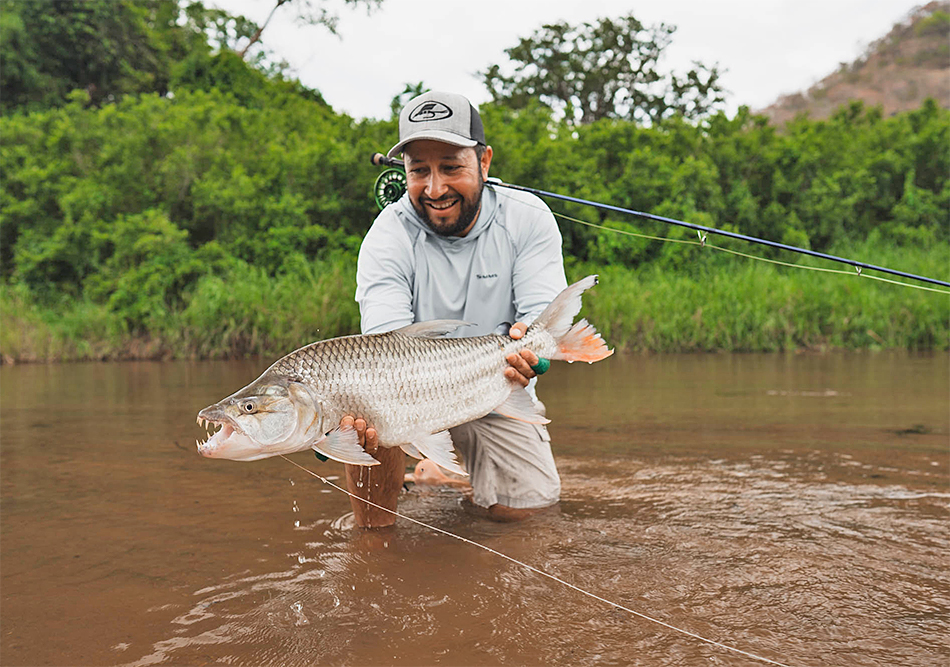
Back out for the afternoon and it was hot. I landed one more small one, lost another one right at the boat and had some more grabs. What a great last day – I was tired. We were at the take-out at 4:00 pm. Broke down rods and were on our way back to the Mnyera. It was a couple hours drive back and we met up there with Malta and Micha. Fishing never really improved for them on the Mnyera. They didn’t land any fish the first day, and just one fish on each of the next 2 days, but one was 10-plus pounds. They still had a good time. We all got caught up, had a nice dinner. One of the hunters came by with a croc they shot earlier in the day, 13.5’. Known on the river as Split Tail. It was cool seeing one up close.
November 11:
Departure day. We had a later breakfast at 8:00 am, packed up, squared up on tips, got our pics from the guides, and headed out by 9:30, to meet the charter at 10:30-10:45 am. We met the incoming group – Matt and Mike who booked through The Fly Shop were on it. We chatted briefly and took off just before 11:00 am. A little bumpy going back. We landed in Dar es Salaam around 1:00 pm and headed to the Sea Cliff around 1:30 pm. The city was drenched in rain and there were huge puddles, the traffic was horrible and there were people everywhere. Motorcycles zigzagging around cars, everyone honking their horns, people selling stuff on the street, walking all around and hanging out at the bus stops. It was a sensory overload after being in remote Africa for a week. We drove through the edge of the city and it was eye-opening to not see one white person the whole drive to the Sea Cliff. It took over an hour to get there, and we got checked in. I took my stuff up to my room, and then took a taxi to buy some souvenirs at a cool little open market called the Slipway and put my negotiating skills to work. I came back and grabbed a bite to eat and Greg came by and we hung out and I bought him dinner. I headed up to my room early and tried to get some sleep as I was leaving at 2 am for a 5 am flight.
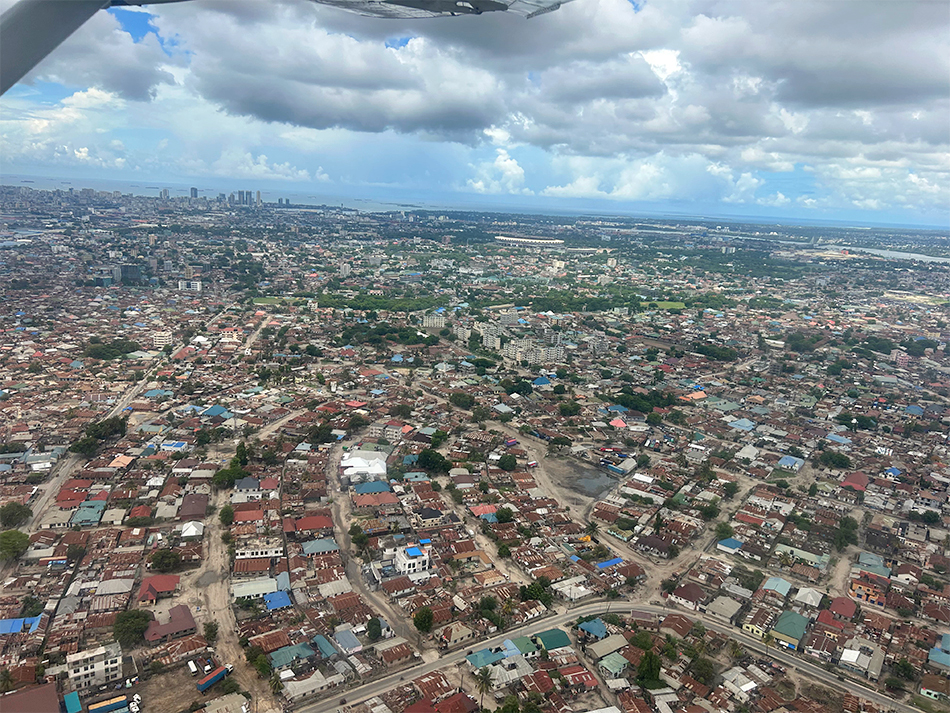
November 12:
It rained all night and we woke up to pouring rain. I got lucky and jumped in with a couple of hunters for a shuttle to the airport. Hillary, with Kilombero Outfitters, picked us up at 2 am so we had plenty of time. There was no traffic but the check-in line was long and slow-going. It took a while. I made it through, but I only got my bag checked to Istanbul as it was too long of a layover to get it all the way to SFO. I was gun-shy about this due to my earlier baggage issues…but as I later found out, it was a non-issue. Immigration line was short as well as security. Made it in with plenty of time to spare for coffee and breakfast. The flight was slightly delayed, by a little over an hour. Boarded around 5:30 am, took off just before 6:30 am. It was nice to not care about the late flight. It could have been 5 hours late.
I landed in Istanbul in the afternoon, went through passport control, got my bag, grabbed a taxi and headed to my hotel. Taxi driver said I was charged through the meter by distance so I jumped in. He said while driving, since I didn’t have Turkish Liras, it was $USD20. I said it was expensive. I think it was supposed to be $10-12 but his English was bad and arguing was a waste of breath. Made it to the Hampton by Hilton, checked in, got a bite to eat, and went to my room and passed out. I think I slept 10-plus hours. I must have needed it.
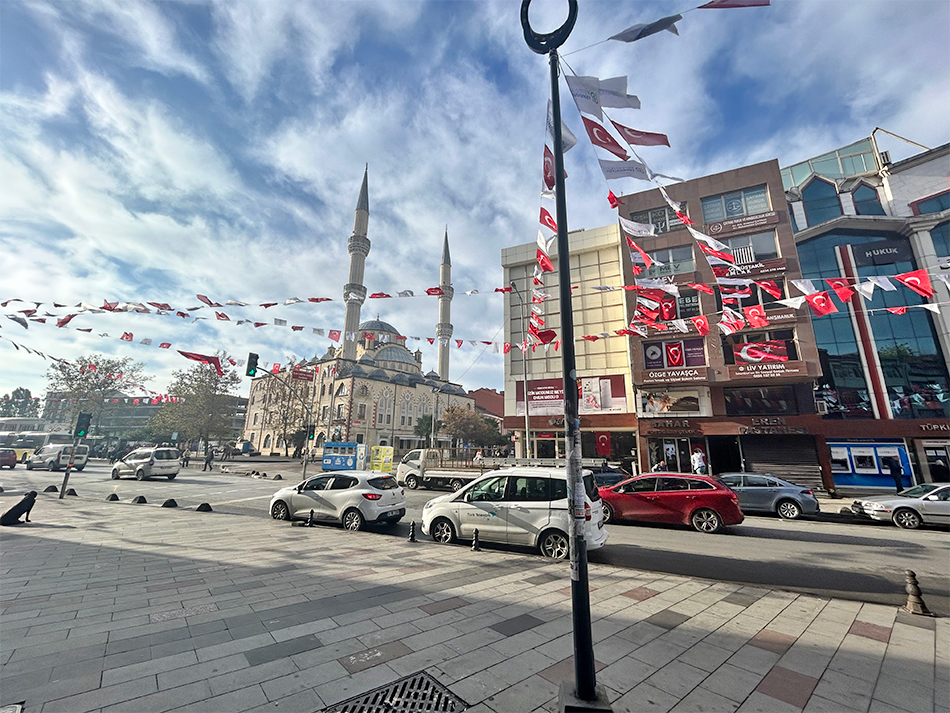
November 13:
Up for breakfast, took my time, checked out and made my way to the airport. Same process – I told the guy at the desk to get me a taxi that takes credit cards. He did. The driver got me to the airport, I tried to pay with CC, it didn’t work, tried again and no go, denied. Driver said $USD25. I laughed and said no way. I showed him the exchange rate from what he wanted to charge me on my phone ($USD14) and gave him $20, that was all I had and got out of there. These guys are shady. I guess looking back it would have been better to get Liras for such things. Made it through check in/passport control/security no problem. I took off a little late, just after 2:15 pm from Istanbul. We landed at 5 pm in SFO, 20 minutes late. My SFO-RDD flight was at 6:35 pm, so it was cutting it close. If bags were delivered on the carousel fast I could make it as there were bag drops and the security line was short. Bags were not fast, I got my bag after 6 pm. It took an hour. I got to the ticket/check-in counter just as they texted me and said they were boarding. I still had to get checked and go through security, so not enough time. Luckily they had an 11:30 pm flight and they put me on it. Late again…of course. We took off just before midnight and made it to RDD at 12:30 am. Took a taxi home and went right to bed. It was quite the trip.
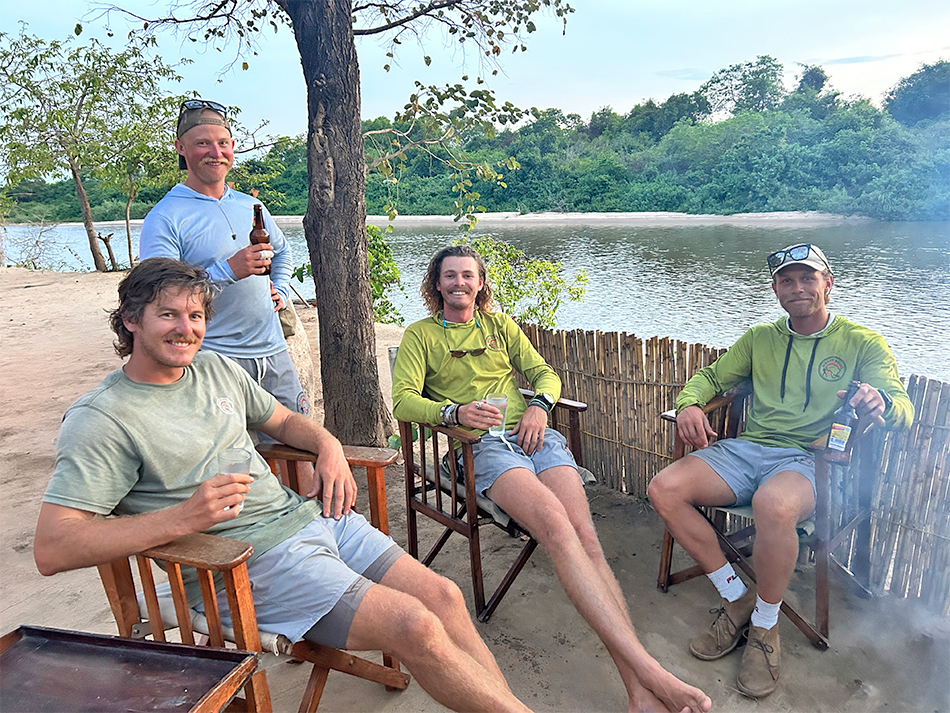
Conclusion:
African Waters has an amazing program in Tanzania. I think anybody that still has a sense of adventure and wants to travel and see wild places and catch an exotic species needs to see this place. I feel places like this are the heart of International Travel and why we do what we do. Fishing with crocs and hippos for an angry fish that is guaranteed to burn your hands should be on everyone’s list.
The rivers are located in a 15,000 sq km protected refuge that allows fishing and hunting. It is truly a wild place that hopefully stays that way. It is remote but still gives you all the amenities of home. Not luxury but comfortable and well run.
Tigerfish are such a unique species and the takes were absolutely addicting to me. They were so explosive and aggressive, I felt a little stunned after getting a proper take and having a fish on. Once you were done, and got your bearings back, you wanted it to happen again. It is like the streamer fisherman’s ultimate quarry. I really enjoyed being poled down the bank and picking it apart. Constantly finding a new target to cast to, and getting into a methodic rhythm until an angry tiger attacks your fly and rips you out of your monotonous trance. I don’t understand why more people aren’t doing this trip.
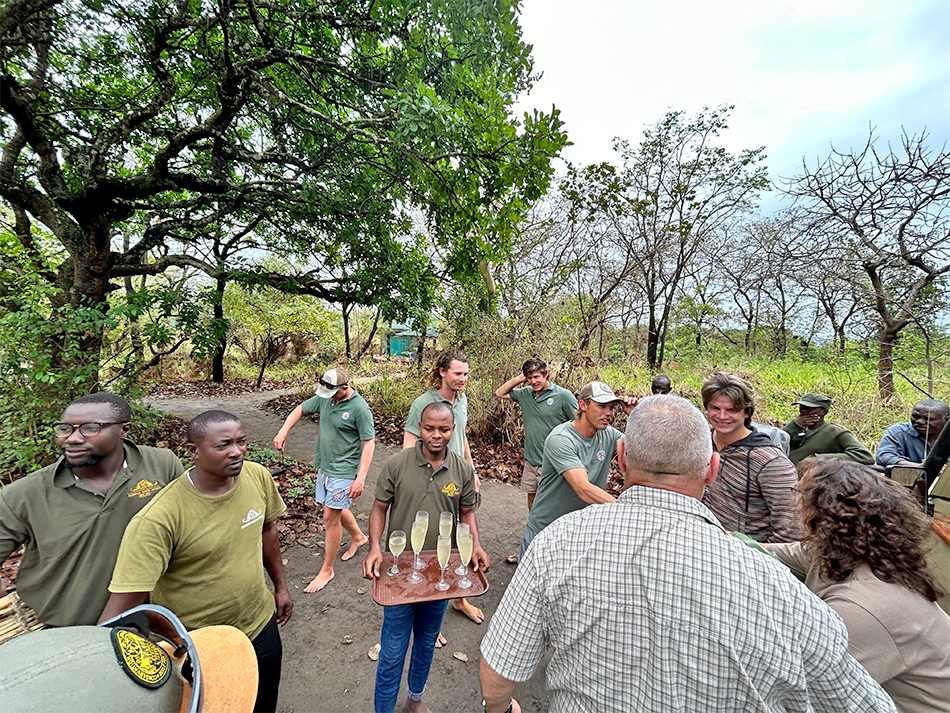
They have the program pretty dialed in, from the welcome drink, the food, tent set-up, the split program, guides and the rest of the staff. It is run really well and you always feel like you are getting taken care of and that they are looking out for your safety on the river and at camp. I think switching it up halfway really makes the program, as in our case if we didn’t switch, it could have been a terrible week. You get to see more of the area and a different river. The African guides are awesome. Greg has been there 12 seasons and Blade, Oliver and Kyle were all great additions to the team and they travel and guide in the other African Water locations. True professionals. For being in such a remote location, the food was really good. Not gourmet meals but flavorful dishes that were both familiar enough to enjoy while mixing in local dishes/flavors to add something more exotic. The bugs were not nearly as bad as I imagined. A couple of times in the early morning or just at dark we got chewed on, but not bad at all.
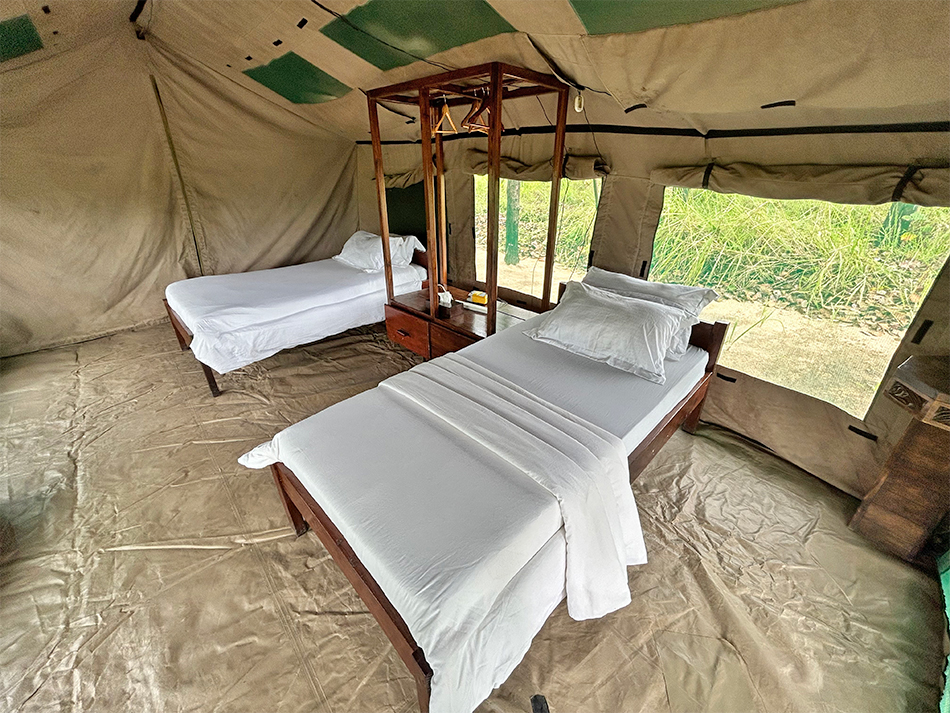
This trip was a great example of how in travel, especially international travel, things don’t always go as planned. We always warn all of our guests about the importance of giving yourself plenty of time to get to a destination and this was a perfect example of why we do that. Most of the time things go smoothly but lately with all the flight cancellations going on – which can have a domino effect on travel – it is even more important to prepare for possible delays and highlights the importance of being fluid and rolling with the changes. The more you travel, the more likely it is these things will happen. It was a great trip and these are the ones that fuel my passion for travel fly fishing. I would go back in a heartbeat.
Notes and some interesting things we saw:
- Asante- “Thank you” in Swahili
- Artemisia-Plant they put in most anti-malaria medication that I had for breakfast in our yogurt
- African skimmer-Rare bird we saw that was nesting on the shoreline .
- Palm nut vulture
- Pel’s fishing owl
- Red-necked Francolin
- Reed buck
- Hartebeest
- Duiker- small deer
- Waterbuck
- Vervet monkey
- Purple-crested turaco
- Narina trogon
- Bee eater- White fronted and European
- Helmeted Guinea Fowl
- Bul bul
- Violet-breasted Sunbird
- Hammerkop-Cool bird that builds these giant nests
- Black chested snake eagle


